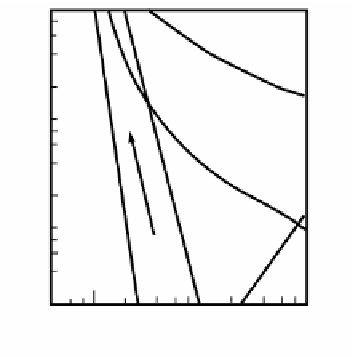Environmental Engineering Reference
In-Depth Information
100
Im
+
In
+
D
Impaction
Impaction +
Interception
10
Diffusion
Interception
1.0
Diffusion +
Interception
Interception
+ Gravity
0.1 1.0 10
Particle Diameter (
µ
m)
Figure 12.2
Relationship between particle size and deposition processes. (From
Hinds, W.C.,
Aerosol Technology — Properties, Behavior, and Measurement of Airborne
Particles,
John Wiley & Sons, New York, 1982. With permission.)
As can be seen in Equation 12.1, the ability of a particle to penetrate a
filter decreases exponentially with increasing filter thickness.
P = e
-rt
(12.1)
where P = penetration, %
e = natural log base
r = fractional capture per unit thickness
t = filter thickness, mm
The value of r depends on particle diameter, packing density, fiber density,
and face velocity of the airstream.
Not surprisingly, easy-to-collect particles are collected on or near the
surface of a filter. As particles move through it, particle size distribution
changes (based on aerodynamic diameters). Each filter type is characterized
by a particle size, usually between 0.05 and 0.5
m, at which fractional
collection efficiencies are minimal. This generalized relationship can be seen
in
Figure 12.3
for particles moving through a filter at 1 and 10 cm/sec. As
face velocity increases, a minimum value for collection efficiency is reached.
Collection due to diffusion at this point is at a minimum. These minimum
collection efficiencies are used to specify the performance of high-efficiency
filters. High-efficiency particulate absolute (HEPA) filters are reported to be
99.97% efficient at 0.3
µ
m. This means that they have a minimum 99.97%
collection efficiency for the most difficult-to-collect particle size.
Collection efficiency is also a function of fiber diameter (
Figure 12.4
)
.
The highest minimum collection efficiency and overall collection efficiency
occur at the smallest fiber diameter tested (0.5
µ
µ
m).


